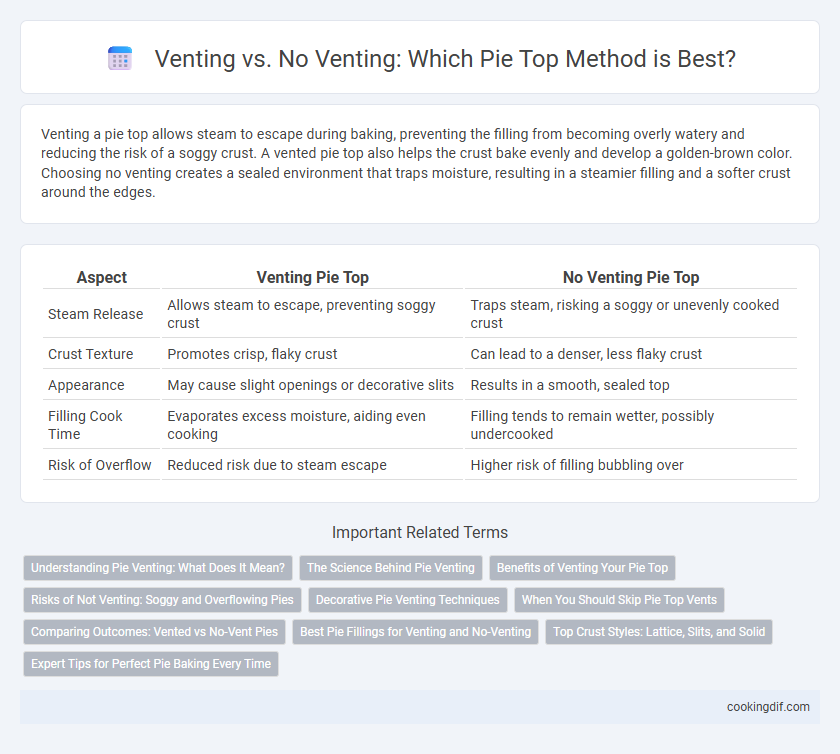Venting a pie top allows steam to escape during baking, preventing the filling from becoming overly watery and reducing the risk of a soggy crust. A vented pie top also helps the crust bake evenly and develop a golden-brown color. Choosing no venting creates a sealed environment that traps moisture, resulting in a steamier filling and a softer crust around the edges.
Table of Comparison
| Aspect | Venting Pie Top | No Venting Pie Top |
|---|---|---|
| Steam Release | Allows steam to escape, preventing soggy crust | Traps steam, risking a soggy or unevenly cooked crust |
| Crust Texture | Promotes crisp, flaky crust | Can lead to a denser, less flaky crust |
| Appearance | May cause slight openings or decorative slits | Results in a smooth, sealed top |
| Filling Cook Time | Evaporates excess moisture, aiding even cooking | Filling tends to remain wetter, possibly undercooked |
| Risk of Overflow | Reduced risk due to steam escape | Higher risk of filling bubbling over |
Understanding Pie Venting: What Does It Mean?
Pie venting refers to the deliberate slits or holes cut into the top crust to allow steam to escape during baking, preventing the filling from becoming overly soggy and the crust from bubbling or cracking. Without venting, trapped steam can cause the pie crust to puff unevenly and create a soggy texture, compromising the overall pie quality. Proper venting ensures even cooking, a crispy top crust, and preserves the pie's intended flavor and texture.
The Science Behind Pie Venting
Pie venting allows steam to escape during baking, preventing the crust from becoming soggy and ensuring a crisp, flaky texture. Without vents, trapped steam creates pressure that can cause the crust to crack or the filling to bubble over, disrupting the pie's structure. The precise placement and size of vents influence heat distribution, promoting even cooking and enhancing the pie's overall quality.
Benefits of Venting Your Pie Top
Venting your pie top allows steam to escape during baking, preventing the crust from becoming soggy and ensuring a crisp, golden finish. Proper venting helps maintain the pie's structural integrity by reducing pressure buildup, which minimizes the risk of cracking or bursting. This technique enhances the overall texture and flavor by promoting even heat distribution and preventing excess moisture inside the pie.
Risks of Not Venting: Soggy and Overflowing Pies
Not venting a pie top traps steam inside, causing the crust to become soggy and insufficiently baked, which compromises texture and flavor. Excess steam buildup increases the risk of pie filling overflowing during baking, resulting in a messy oven and uneven cooking. Proper venting ensures moisture escapes, maintaining a crisp crust and preventing spills.
Decorative Pie Venting Techniques
Decorative pie venting techniques enhance both the aesthetic and functional aspects of pie tops by allowing steam to escape without sacrificing visual appeal. Popular methods include lattice patterns, leaf-shaped cutouts, and intricate slits that create appealing designs while preventing soggy crusts. Implementing these venting styles ensures even baking and maintains the pie's structural integrity, contributing to a perfect golden finish.
When You Should Skip Pie Top Vents
Skipping pie top vents is advisable when making fruit pies with thick fillings that release minimal steam during baking. Pies with dense, custard-like fillings or those topped with a full crust can trap moisture, preventing the filling from drying out and producing a smoother texture. Avoid venting when the goal is a glossy, evenly baked crust that maintains structural integrity and prevents leaking.
Comparing Outcomes: Vented vs No-Vent Pies
Vented pie tops allow steam to escape during baking, preventing soggy crusts and ensuring a crisp, flaky texture, while no-vent pies often trap moisture that can lead to a denser, softer crust. Research shows vented pies maintain a golden-brown finish and preserve the filling's flavor by avoiding excess moisture buildup. In contrast, no-vent pies can result in a moister interior but risk a less desirable texture due to steam retention.
Best Pie Fillings for Venting and No-Venting
When choosing the best pie fillings for venting, fruit-based fillings such as apple, cherry, and blueberry benefit from steam escaping through venting to prevent sogginess and ensure a crisp crust. No-venting is ideal for custard or cream pies like pumpkin or chocolate, where retaining moisture is crucial to maintain a smooth texture and prevent drying. Understanding the filling's moisture content guides whether to use a vented or unvented pie top for optimal baking results.
Top Crust Styles: Lattice, Slits, and Solid
Top crust styles for pies, such as lattice, slits, and solid, significantly impact ventilation and texture. Lattice crusts offer optimal venting by allowing steam to escape through the woven strips, preserving a tender filling while achieving a crisp exterior. Slits provide targeted steam release to prevent sogginess, whereas solid crusts require strategic vent holes to avoid a soggy or overly moist top, influencing the pie's overall appearance and baking time.
Expert Tips for Perfect Pie Baking Every Time
Venting the pie top allows steam to escape, preventing soggy crusts and ensuring a flaky, golden finish. Experts recommend cutting precise slits or using lattice patterns to balance steam release without compromising the pie's structure. For fruit pies, adequate venting enhances filling consistency and avoids overflow during baking.
Venting vs no venting for pie top Infographic

 cookingdif.com
cookingdif.com